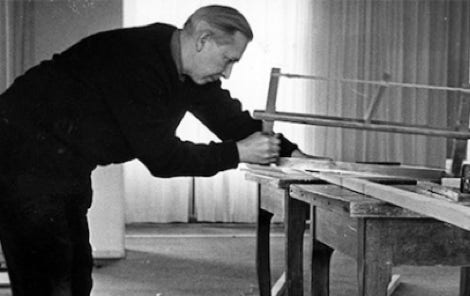-15% off with DESIGN15
The production history of Hans J. Wegner's Oculus CH468 chair is a bit out of the ordinary. While visiting Wegner's design studio, Carl Hansen & Søn became very interested in some photos and a small clay model of an armchair from the 1960s. It was not until Wegner's technical drawings were recovered and that Carl Hansen & Søn had the opportunity to study one of the only two full-scale prototypes recorded in the world of the Oculus from 1960 that it became possible to start production in 2010.
The CH468 sports a very round, underlined by the armrests and the large headrest, which contrasts with the slenderness of its metal legs. The backrest is made up of three parts which provide support to the back, shoulders and head respectively, giving it excellent comfort. The chair takes its name Oculus from the Latin "eye" in reference to the back upholstery that features this shape. The interior structure of the CH468 armchair is in solid beech, with one of the largest pieces of thermoformed wood in contemporary furniture, and its stainless steel base, guaranteeing incomparable stability and solidity.
It is surprising to think that the CH468, which embodies the quintessence of Danish design furniture, will have waited 50 years to be born.
Lounge chair 94 x 94 x H105 cm – seat height 40 cm, armrests height 65 cm
Footstool 62,5 x 49 x H37,5 cm
Inner frame solid beech Base stainless steel
Seat and backrest european down, flame retardant cold foam,
fabric or leather upholstery
CH468 Oculus armchair
from
CH446 Footrest
from
Fiord fabric 151 (price group 3)
Thor leather 377 (price group B)
Sif leather 98 (price group C)
Mood fabric 4102 (price group 1)
Fiord fabric 191 (price group 3)
Mood fabric 1101 (price group 1)
Mood fabric 2101 (price group 1)
Mood fabric 3101 (price group 1)
Fiord fabric 151 (price group 3)
Mood fabric 8101 (price group 1)
Hallingdal fabric 180 (price group 3)
Hans J. Wegner



Hans J. Wegner was born in 1914 in Tønder, Denmark, the son of a shoemaker. At the age of 17, he finished his apprenticeship as a cabinetmaker with H. F. Stahlberg, in whose workshops Wegner’s first design experiments took form. He moved to Copenhagen as a 20 year-old, and attended the School of Arts and Crafts from 1936 – 1938 before he began working as an architect.
As a young architect, Wegner joined Arne Jacobsen and Erik Møller in Århus, working on furniture design for the new Århus city hall in 1940. It was during the same year that Wegner began collaborating with master cabinetmaker, Johannes Hansen, who was a driving force in bringing new furniture design to the Danish public.
The Copenhagen Museum of Art and Industry acquired its first Wegner chair in 1942.
Wegner started his own design office in 1943. It was in 1944 that he designed the first “Chinese chair” in a series of new chairs that were inspired by portraits of Danish merchants sitting in Ming chairs. One of these chairs, the “Wishbone Chair”, designed in 1949 and produced by Carl Hansen & Son in Odense since 1950, became the most successful of all Wegner chairs.
Among Danish furniture designers, Hans J. Wegner is considered one of the most creative and productive. He has received practically every major recognition given to designers, including the Lunning prize, the grand prix of the Milan Triennale, Sweden’s Prince Eugen medal and the Danish Eckersberg medal. Wegner is an honorary Royal designer for industry of the Royal Society of Arts in London. Almost all of the world’s major design museums – from The Museum of Modern Art in New York to Die Neue Sammlung in Munich – include his furniture in their collections.
Hans J. Wegner died in Denmark in January, 2007.
Hans J. Wegner’s contribution to Danish Modern:
- First a cabinetmaker, then a designer: integrates exacting joinery techniques and exquisite form.
- A deep respect for wood and its characteristics – and an abiding curiosity about other natural materials
- Brings an organic, natural softness to formalistic minimalism
- Generally regarded as ”the master of the chair”, with more than 400 chair designs to his name.
Cheaper elsewhere? Contact us for a counter-offer!
Ce site web utilise les cookies techniques pour fonctionner.
Vous pouvez les refuser, mais perdrez alors la possibilité d'acheter.
OK
Refuser